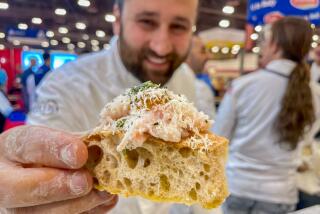RESTAURANTS : Mozzarella!!
- Share via
“There are no buffalo in Italy.” The words of Pazzia’s Mauro Vicente are slow and emphatic. “Where would they go? In Italy, we’ve barely got room for the cows.” He pauses a moment. “But there are bufala .”
You might wonder, isn’t a bufala a buffalo? Well, yes and no. You can call a bufala (pronounced BOO - fala ) a buffalo if you mean water buffalo, but if your idea of a buffalo looks like something Buffalo Bill Cody once shot at, you’re talking bison. The difference is easy to figure if you remember bison roam the range and bufala wallow in mud.
In the game of foodie one-upmanship, this is all vital stuff. After all, from the humble Italian bufala comes what every food expert agrees is the best tasting mozzarella cheese in the world.
There was a time when mozzarella di bufala was no big deal. Plain old pizza cheese is a direct descendant from fresh bufala mozzarella, and of all the world’s cheeses it is among the simplest to make. But as the water buffalo population decreased in Italy, the number of self-proclaimed cheese connoisseurs in the world grew unwieldy . . . a fad was born.
Vincente talks of a band of modern-day Italian Luddites (inspired by the 19th-Century British anti-progress rioters who tried to stop the Industrial Revolution), who keep eight water buffalo in a small swamp, and make the most wonderful mozzarella he’s ever tasted. But unless you travel to that bog, you’ll never taste it.
And to make things truly annoying for aspiring cheese snobs, what matters most in mozzarella is not buffalo milk, but freshness. New York’s Italian cheese makers do just fine with cow milk. In Italy, fior di latte (mozzarella from cow’s milk), has long dominated the market.
Darrell Corti (of California’s famous foodie emporium, Corti Bros. in Sacramento), who imports bufala mozzarella for his store, admits that if given a choice between five-day-old bufala mozzarella and freshly made mozzarella from cow’s milk, he’d choose the cow. “You’ve always got to go with the fresh,” he says. Even Mauro Vincente doesn’t go to the trouble to import bufala mozzarella for his restaurants. “Planes are like horses, they stop everywhere they can,” he says. “By the time the cheese gets to the restaurant it might be five, six days old--and after the third day you start losing flavor.
Michael Chiavello, who makes his own mozzarella fresh by hand everyday for his restaurant, Tra Vigne in St. Helena, believes in eating the cheese the same day its made. “There are no in-betweens with mozzarella,” he says. “Day one, it’s as perfect as cooking can be. The next day it’s not--it’s like reheating a steak.”
You might as well use it for, well, pizza.
“You use up old mozzarella in eggplant Parmesan or lasagna,” Corti says. “Fresh mozzarella you eat raw or in a Caprese salad, which is really good mozzarella, really good tomato, really good olive oil, fresh basil leaves and ground pepper.
“Traditional American-style mozzarella has nothing to do with mozzarella--it is in fact a semi-Provolone, hard and rubbery as opposed to real mozzarella which is this cheese that’s kneaded in hot water so that it retains part of its whey,” Corti says. “Real mozzarella should ooze a white liquid when you cut it. It should smell like fresh milk.”
Because of the bad reputation of American mozzarella, Virgilio Cicconi of Italcheese in Carson decided to make morbidella , which is in the mozzarella family. “If I called it mozzarella, people would think of the supermarket cheese, and that’s hard as rocks,” he says. Ironically, his cheese is now sold in several supermarket chains (Hughes, Gelson’s) and more than 200 restaurants. The morbidella isn’t as delicate as hand-made mozzarella--it has the same shelf life as milk--but it is very close to the machine-made mozzarella in Italy.
Cicconi, Chiavello and Santa Rosa cheese maker Laura Chenel all talk about the difference between the Italian cow and the American cow. Mostly, it’s a matter of diet. Because Italian cattle feed on grass year-round, the milk is grassy tasting; American cattle fatten up on grain for much of the year, making what Chenel calls “bland, one-dimensional” milk. (“Americans don’t want to taste their milk,” Chiavello says.)
Cicconi adds a lactic ferment to his cheese, which gives it the good, slightly sour taste Italian mozzarella usually has. And to make a cheese that is as close to bufala mozzarella without using buffalo milk, Chiavello and Chenel have both experimented with mixing goat milk into cow milk to make--we kid you not-- goatzarella.
But all three cheese makers agree that bufala is best. “And how do you recognize a good bufala mozzarella? Bite into it,” Vincente says. “If your mouth is greasy, and your lips are greasy, and you have a full taste, then that’s mozzarella di bufala --with only one ‘f.’ OK?”
More to Read
Sign up for The Wild
We’ll help you find the best places to hike, bike and run, as well as the perfect silent spots for meditation and yoga.
You may occasionally receive promotional content from the Los Angeles Times.







